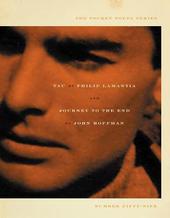
|
Tau & Journey to the End
Paperback / softback
Main Details
| Title |
Tau & Journey to the End
|
| Authors and Contributors |
By (author) Philip Lamantia
|
|
By (author) John Hoffman
|
| Series | City Lights Pocket Poets Series |
|---|
| Physical Properties |
| Format:Paperback / softback | | Pages:150 | | Dimensions(mm): Height 160,Width 121 |
|
| Category/Genre | Poetry by individual poets |
|---|
| ISBN/Barcode |
9780872864856
|
| Classifications | Dewey:811.54 |
|---|
| Audience | |
|---|
|
Publishing Details |
| Publisher |
City Lights Books
|
| Imprint |
City Lights Books
|
| Publication Date |
17 April 2008 |
| Publication Country |
United States
|
Description
Two long-lost volumes from the classic Beat period. Tau is Philip Lamantia's mystical second collection of poems, originally slated for publication in 1955, but suppressed by the poet due to his evolving religious beliefs. Journey to the End contains the poems of the legendary John Hoffman (1928-1952), whose poems were read by Lamantia in 1955 at the 6 Gallery reading where Allen Ginsberg debuted "Howl." Lamantia's closest friend, a character in Jack Kerouac's Dharma Bums, and the inspiration for two lines of "Howl," Hoffman moved between San Francisco and New York before his death in Mexico at the age of twenty-four. This volume includes biographical notes and Lamantia's commentaries on Hoff man's poetry.
Author Biography
Philip Lamantia (1927-2005) became a nationally-known poet at 15, published by surrealist magazines View and VVV. He became a major twentieth century poet, precursor to and fellow traveler with the Beat Generation. Reflecting his esoteric mysticism and use of consciousness-expanding drugs, Lamantia's poetry is considered the primary link between the European avant-garde and American counterculture. John Hoffman (1928-1952) is a legendary member of the original Beat Generation poets. Dying of unknown causes on a trip to Mexico, he remained unpublished during his lifetime. In 1955, Philip Lamantia read Hoffman's poetry at the 6 Gallery reading where Ginsberg debuted "Howl." This is the first appearance of Hoffman's poetry in any widely-available form.
ReviewsHere are Philip Lamantia's light-scattering jewels of the Fifties!--Michael McClure, author of Huge Dreams: San Francisco and Beat Poems The rediscovery of Tau is the literary equivalent of finding lost treasure. Alchemical gold--blood of pure imagination--courses through these lines by the magus of American poetry.--Andrew Joron, author of The Cry at Zero: Selected Prose To some, Philip Lamantia (1927-2005) needs no introduction, but to others he may. Let it suffice to say that the San Francisco-born surrealist was one of the most significant American poets of the latter half of the 20th century, participating in the San Francisco Renaissance and associating with the Beats, though remaining aloof from their aesthetic[. . . .] Among [the] hidden gems [of the Philip Lamantia Bancroft papers] was one complete manuscript, Tau, announced for publication by Bern Porter in 1955 but withdrawn by the poet because of his evolving religious beliefs. By all rights, Tau should have been his second book, and I later had the pleasure of editing it for publication as #59 of the City Lights Pocket Poets series (2008).--Garret Caples, Bancroftiana These are the early poems of Philip Lamantia that he was supposed to read at the famous Six Gallery reading in 1955, when Allen Ginsberg read 'Howl.' Philip had misgivings about these poems, because he didn't think that they were worthy of his newly-found or re-found Catholic faith. From 2008 it's hard to see the problem: On a smiling crevice of street, / He cuts, for death, the diamond of her eye: / Star plumed hands put it / Burning on his brow. Sounds pretty Fra Angelico to us. John Hoffman (1928-1952) was Philip's friend who died young and wrote luminous Zen-inspired works. 'Therefore unattained is / The sudden attainment.'--Andrei Codrescu
|